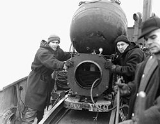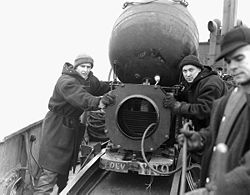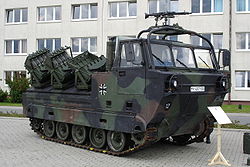
Minelayer
Encyclopedia

Naval ship
A naval ship is a ship used for combat purposes, commonly by a navy. Naval ships are differentiated from civilian ships by construction and purpose...
used for deploying naval mine
Naval mine
A naval mine is a self-contained explosive device placed in water to destroy surface ships or submarines. Unlike depth charges, mines are deposited and left to wait until they are triggered by the approach of, or contact with, an enemy vessel...
s. "Mine planting" was the term used for installing controlled mines
Controlled mines
A Controlled Mine was a circuit fired weapon used in coastal defenses with ancestry going back to 1805 when Robert Fulton termed his underwater explosive device a torpedo:...
at predetermined positions in connection with coastal fortifications or harbor approaches that would be detonated by shore control when a ship was fixed as being within the mine's effective range.
Before World War I, mine ships were termed mine planters
Mine Planter (ship)
Mine planter and the earlier "torpedo planter" was a term used for mine warfare ships into the early days of World War I. In later terminology, particularly in the United States, a mine planter was a ship specifically designed to install controlled mines or contact mines in coastal fortifications...
generally. For example, in an address to the U.S. Navy ships of Mine Squadron One at Portland, England Admiral Sims used the term “mine layer” while the introduction speaks of the men assembled from the “mine planters”. During and after that war the term "mine planter" became particularly associated with defensive coastal fortifications. The term "minelayer" applied vessels deploying both defensive and offensive mine barrages and large scale sea mining. "Minelayer" lasted well past the last common use of "mine planter" in the late 1940s.
An army's special-purpose combat engineering vehicles used to lay landmines are sometimes called "minelayers".
Naval minelayers
The most common use of the term "minelayer" is a naval shipNaval ship
A naval ship is a ship used for combat purposes, commonly by a navy. Naval ships are differentiated from civilian ships by construction and purpose...
used for deploying sea mine
Naval mine
A naval mine is a self-contained explosive device placed in water to destroy surface ships or submarines. Unlike depth charges, mines are deposited and left to wait until they are triggered by the approach of, or contact with, an enemy vessel...
s. In the Gallipoli Campaign of World War I
World War I
World War I , which was predominantly called the World War or the Great War from its occurrence until 1939, and the First World War or World War I thereafter, was a major war centred in Europe that began on 28 July 1914 and lasted until 11 November 1918...
, mines laid by the Ottoman Empire's Navy
Turkish Navy
The Turkish Navy is the naval warfare service branch of the Turkish Armed Forces.- Ottoman fleet after Mudros :Following the demise of the Ottoman Empire in the aftermath of World War I, on November 3, 1918, the fleet commander of the Ottoman Navy, Liva Amiral Arif Pasha, ordered all flags to be...
's Nusret sank , , and the French battleship Bouvet
French battleship Bouvet
The Bouvet was a French pre-dreadnought battleship, launched in 1896 and sunk by a mine in 1915 during World War I.Bouvet, named for the maritime family of Bouvet de Lozier, the most famous being French Admiral François Joseph Bouvet, belonged to the Jauréguiberry quasi-class which comprised...
in the Dardanelles
Dardanelles
The Dardanelles , formerly known as the Hellespont, is a narrow strait in northwestern Turkey connecting the Aegean Sea to the Sea of Marmara. It is one of the Turkish Straits, along with its counterpart the Bosphorus. It is located at approximately...
on 18 March 1915. Russian minelayers were also efficient; sinking the Japanese battleships Hatsuse
Japanese battleship Hatsuse
|-External links:**...
and Yashima
Japanese battleship Yashima
|-External links:** The New York Times, June 2, 1905....
in 1904 during the Russo-Japanese War
Russo-Japanese War
The Russo-Japanese War was "the first great war of the 20th century." It grew out of rival imperial ambitions of the Russian Empire and Japanese Empire over Manchuria and Korea...
.
In World War II, the British employed the Abdiel class minelayer
Abdiel class minelayer
The Abdiel class were a class of six fast minelayers commissioned into the Royal Navy and active during the Second World War. They were also known as the Manxman class and as "mine-laying cruisers".-Design:...
s both as minelayers and as transports to isolated garrisons, such as Malta
Malta
Malta , officially known as the Republic of Malta , is a Southern European country consisting of an archipelago situated in the centre of the Mediterranean, south of Sicily, east of Tunisia and north of Libya, with Gibraltar to the west and Alexandria to the east.Malta covers just over in...
and Tobruk
Tobruk
Tobruk or Tubruq is a city, seaport, and peninsula on Libya's eastern Mediterranean coast, near the border with Egypt. It is the capital of the Butnan District and has a population of 120,000 ....
. Their combination of high speed (up to 40 knots) and carrying capacity was highly valued. The French used the same concept for the Pluton
French cruiser Pluton
The Pluton was a fast minelaying cruiser built for the French Navy in the late 1920s. She was also able to carry 1,000 troops on her mine deck as a fast troop transport. Shortly after completion she was modified and became a gunnery training ship, replacing the elderly armored cruiser...
.
A naval minelayer can vary considerably in size, from coastal boats of several hundred tonnes in displacement to destroyer
Destroyer
In naval terminology, a destroyer is a fast and maneuverable yet long-endurance warship intended to escort larger vessels in a fleet, convoy or battle group and defend them against smaller, powerful, short-range attackers. Destroyers, originally called torpedo-boat destroyers in 1892, evolved from...
-like ships of several thousand tonnes in displacement. Apart from their loads of sea mines, most would also carry other weapons for self-defense.
Submarine
Submarine
A submarine is a watercraft capable of independent operation below the surface of the water. It differs from a submersible, which has more limited underwater capability...
s can also act as minelayers. The first submarine to be designed as such was the Russian submarine Krab. was also one such minelaying submarine.
In modern times, most navies worldwide no longer possess minelaying vessels; the United States Navy
United States Navy
The United States Navy is the naval warfare service branch of the United States Armed Forces and one of the seven uniformed services of the United States. The U.S. Navy is the largest in the world; its battle fleet tonnage is greater than that of the next 13 largest navies combined. The U.S...
, for example, uses aircraft
Aircraft
An aircraft is a vehicle that is able to fly by gaining support from the air, or, in general, the atmosphere of a planet. An aircraft counters the force of gravity by using either static lift or by using the dynamic lift of an airfoil, or in a few cases the downward thrust from jet engines.Although...
to lay sea mines instead. Mines themselves have evolved from purely passive to active; for example in the U.S. CAPTOR (enCAPsulated TORpedo)
CAPTOR mine
The CAPTOR is the United States Navy's primary anti-submarine naval mine. This deep-water mine is laid by ship, aircraft or submarine, and is anchored to the ocean floor. When its sonar detects a hostile submarine, the CAPTOR launches a Mark 46 torpedo.The name CAPTOR is short for enCAPsulated...
that sits as a mine until detecting a target upon which a torpedo is launched. A few navies still have minelayers in commission, including those of Turkey
Turkish Navy
The Turkish Navy is the naval warfare service branch of the Turkish Armed Forces.- Ottoman fleet after Mudros :Following the demise of the Ottoman Empire in the aftermath of World War I, on November 3, 1918, the fleet commander of the Ottoman Navy, Liva Amiral Arif Pasha, ordered all flags to be...
, South Korea
Republic of Korea Navy
The Republic of Korea Navy or the ROK Navy is the branch of the South Korean armed forces responsible for conducting naval operations and amphibious landing operations. The ROK Navy includes the Republic of Korea Marine Corps, which is a quasi-autonomous organization...
, Norway
Royal Norwegian Navy
The Royal Norwegian Navy is the branch of the Norwegian Defence Force responsible for naval operations. , the RNoN consists of approximately 3,700 personnel and 70 vessels, including 5 heavy frigates, 6 submarines, 14 patrol boats, 4 minesweepers, 4 minehunters, 1 mine detection vessel, 4 support...
, Sweden
Swedish Navy
The Royal Swedish Navy is the naval branch of the Swedish Armed Forces. It is composed of surface and submarine naval units – the Fleet – as well as marine units, the so-called Amphibious Corps .In Swedish, vessels of the Swedish Navy are given the prefix "HMS," short for Hans/Hennes...
and Finland
Finnish Navy
The Finnish Navy is one of the branches of the Finnish Defence Forces. The Navy employs 2,300 people and about 4,300 conscripts are trained each year. Finnish Navy vessels are given the ship prefix "FNS" simply short for "Finnish Navy Ship"...
, countries with long, shallow coastlines where sea mines are most effective.

Aerial minelaying
Beginning in World War IIWorld War II
World War II, or the Second World War , was a global conflict lasting from 1939 to 1945, involving most of the world's nations—including all of the great powers—eventually forming two opposing military alliances: the Allies and the Axis...
, aircraft
Military aircraft
A military aircraft is any fixed-wing or rotary-wing aircraft that is operated by a legal or insurrectionary armed service of any type. Military aircraft can be either combat or non-combat:...
were used to deliver naval mines by dropping them, attached to a parachute
Parachute
A parachute is a device used to slow the motion of an object through an atmosphere by creating drag, or in the case of ram-air parachutes, aerodynamic lift. Parachutes are usually made out of light, strong cloth, originally silk, now most commonly nylon...
. Germany
Germany
Germany , officially the Federal Republic of Germany , is a federal parliamentary republic in Europe. The country consists of 16 states while the capital and largest city is Berlin. Germany covers an area of 357,021 km2 and has a largely temperate seasonal climate...
, Britain
United Kingdom
The United Kingdom of Great Britain and Northern IrelandIn the United Kingdom and Dependencies, other languages have been officially recognised as legitimate autochthonous languages under the European Charter for Regional or Minority Languages...
, and the U.S.
United States
The United States of America is a federal constitutional republic comprising fifty states and a federal district...
made significant use of aerial minelaying.
A new type of magnetic mine dropped by a German aircraft in a campaign of mining the Thames Estuary in 1939 landed in a mudflat, where disposal experts determined how it worked, which allowed Britain to fashion appropriate mine countermeasures.
The RAF operations were codenamed "Gardening". As well as mining the North Sea and approaches to German ports, mines were laid in the Danube River near Belgrade
Belgrade
Belgrade is the capital and largest city of Serbia. It is located at the confluence of the Sava and Danube rivers, where the Pannonian Plain meets the Balkans. According to official results of Census 2011, the city has a population of 1,639,121. It is one of the 15 largest cities in Europe...
, Yugoslavia
Yugoslavia
Yugoslavia refers to three political entities that existed successively on the western part of the Balkans during most of the 20th century....
, starting on 8 April 1944, to block the shipments of petroleum product
Petroleum product
Petroleum products are useful materials derived from crude oil as it is processed in oil refineries.According to crude oil composition and demand, refineries can produce different shares of petroleum products. The largest share of oil products is used as energy carriers: various grades of fuel...
s from the refineries at Ploeşti
Ploiesti
Ploiești is the county seat of Prahova County and lies in the historical region of Wallachia in Romania. The city is located north of Bucharest....
, Romania
Romania
Romania is a country located at the crossroads of Central and Southeastern Europe, on the Lower Danube, within and outside the Carpathian arch, bordering on the Black Sea...
.
In the Pacific
Pacific War
The Pacific War, also sometimes called the Asia-Pacific War refers broadly to the parts of World War II that took place in the Pacific Ocean, its islands, and in East Asia, then called the Far East...
, the U.S. dropped thousands of mines in Japanese home waters
Operation Starvation
Operation Starvation was an American naval mining operation conducted in World War II by the Army Air Force, in which vital water routes and ports of Japan were mined by air in order to disrupt enemy shipping.-Operation:...
, contributing to that country's defeat.
Aerial mining was also used in the Korean War
Korean War
The Korean War was a conventional war between South Korea, supported by the United Nations, and North Korea, supported by the People's Republic of China , with military material aid from the Soviet Union...
and in Vietnam
Vietnam War
The Vietnam War was a Cold War-era military conflict that occurred in Vietnam, Laos, and Cambodia from 1 November 1955 to the fall of Saigon on 30 April 1975. This war followed the First Indochina War and was fought between North Vietnam, supported by its communist allies, and the government of...
. In Vietnam, rivers and coastal waters were extensively mined with a modified bomb called a destructor that proved very successful.
Landmine laying
Some examples of minelaying vehicles:- Shielder minelaying systemShielder minelaying systemThe Shielder minelaying system is used by the British Army to quickly create anti-tank barriers. The system is based on the American Alliant Techsystems M163 Volcano system. It was ordered in 1995 and was first deployed in 1999....
- GMZ family of minelayers, which the 2S4 Tyulpan2S4 TyulpanThe 2S4 Tyulpan is a Soviet self-propelled mortar. "2S4" is its GRAU designation.It was identified for the first time in 1975 in the Soviet army and so was called M-1975 by NATO , whereas its official designation is SM-240...
is based on, using TM-62 series minesTM-62 series of minesTM-62 is the designation for a series of Russian anti-tank blast mines. The mines have a central fuze and typically have a 7.5 kg explosive charge, however they vary greatly in detail... - Minenwerfer Skorpion

- Type94 Minelayer
- El-Fahda (Egypt)
- Istrice (M113 variant)
See also
- Mine Planter (ship)Mine Planter (ship)Mine planter and the earlier "torpedo planter" was a term used for mine warfare ships into the early days of World War I. In later terminology, particularly in the United States, a mine planter was a ship specifically designed to install controlled mines or contact mines in coastal fortifications...
- Minesweeper (ship)Minesweeper (ship)A minesweeper is a small naval warship designed to counter the threat posed by naval mines. Minesweepers generally detect then neutralize mines in advance of other naval operations.-History:...
- Submarine mines in U.S. harbor defenseSubmarine mines in U.S. harbor defenseThe modern era of defending American harbors with submarine mines began in the post-Civil War period.In 1866, the U.S. [Army] Corps of Engineers established the Engineer School of Application at Willets Point, NY. The first commander of this School, Maj...

